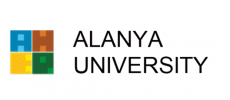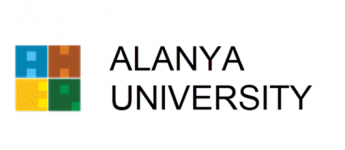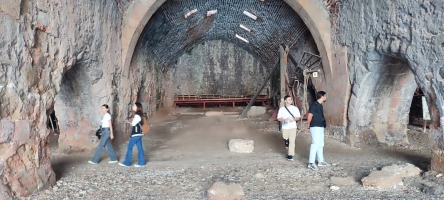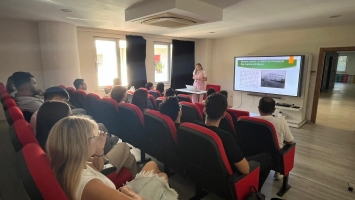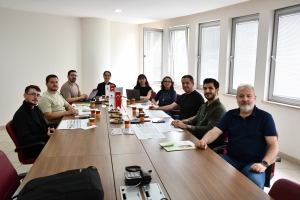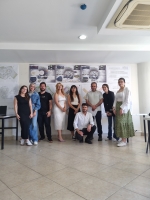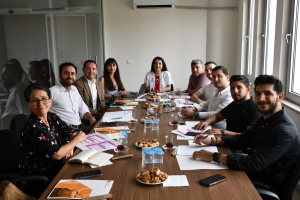As part of the ‘Palimpsest Cities: Alanya’ course with our Architecture Department students, we organized a gamified field trip to Kızılkule and Tersane under the coordination of our cours...
Architecture (without Thesis) -Turkish
» Bologna Information Package
» Documents and Forms
» Postgraduate thesis writing guide
» Application Guide
Head of Department
Dr. Faculty Member Elif Gizem Yetkin
Program Director
Dr. Faculty Member Elif Gizem Yetkin
Program Overview
Courses
MIM 501 Research Methods and Techniques (3+0) 3 7.5 ECTS This course aims to raise awareness among learners about the scientific research processes, techniques, and methods and contribute to the application of the knowledge and skills acquired in this course in their educational as well as daily lives. The curriculum includes the introduction of scientific concepts, structuring a scientific research, characteristics and processes of qualitative, quantitative, and mixed methods, and the methods of scientific research in architecture.
MIM 539 Systems Thinking (3+0) 3 7.5 ECTS This course aims to see the world in an unconventional way, showing how certain "things" affect situations when approaching them or performing certain activities. It discusses how systems thinking can be useful while analyzing and developing situations. The process of system modeling is summarized and discussed. Models are adapted to different situations as a part of the systems approach. Mastery of system concepts and language is aimed for. In this direction, diagrams are used as a strong support in systems thinking and applications, and the representation of information and conceptualization of complex situations through diagrams are discussed.
MIM 540 New Cities (3+0) 3 7.5 ECTS The aim of this course is to discuss how architecture has been successful or not in creating new environments through large urbanization, garden cities, and new cities. Topics discussed in this course include ways of thinking about creating human habitats in architecture, architectural styles of large-scale housing projects, the role of complex perspectives in architectural structures, and the role of construction technologies in creating architectural environments.
MIM 505 Term Project (0) 7.5 ECTS This course provides the student with the opportunity to independently research, evaluate, and present a study on a topic chosen with an academic advisor by conducting scientific research. As part of this research process, the student prepares research proposals and experimental studies developed during their master's courses.
MIM 508 Advanced Presentation Techniques (3+0) 3 7.5 ECTS This course aims to enhance skills in architectural thought and designs presentation methods, techniques, and auxiliary computer programs used in architectural visual presentation.
MIM 509 Architecture and Local Governments (3+0) 3 7.5 ECTS This course evaluates the causes and environmental outcomes of urbanization on global and local scales; discusses city history and culture, urban sociology, urban architecture/urban design, and the role of local governments in these areas. The course aims to assess the social, political, economic, and environmental outcomes of urbanization; understand the duties and responsibilities of local governments in this area; and be sensitive to environmental and ecological issues.
MIM 510 Design Theory and Methods (3+0) 3 7.5 ECTS This course discusses the relationships and parallel developments between design methods and design research. It focuses on paradigm shifts known as the first and second generations in design methods and the relationship between these paradigms and design research. Developments in design science and their reflections on current design research are examined. The aim of this course is to understand the problems included in traditional design methods; explain contemporary problem-solving and design methods with all their components; and explain the applications of these methods in the field of architecture through examples.
MIM 511 Building Elements and Materials (3+0) 3 7.5 ECTS This course aims to introduce building materials and research their application methods. It examines the relationship between designers, material manufacturers, and users within the building material production sector. It aims to identify the problems and/or opportunities created by materials in design and use.
MIM 513 Energy Efficient Building Practices (3+0) 3 7.5 ECTS The aim of this course is for students to learn about energy-efficient building applications, passive and active climate control systems, the use of sunlight and soil heat, green buildings, and green building certification systems. It focuses on ecology, energy, and environmental concepts, effective architectural design approaches, the basic principles of energy-efficient building design, interdisciplinary and integrated design strategies, and performance-based design approaches.
MIM 514 Investment Analysis and Real Estate Valuation Principles (3+0) 3 7.5 ECTS This course examines methods for determining the profitability of an investment and calculating the market value of real estates using different methods. It discusses the time value of money, cash flow schemes, types of interest and calculations, payback period method, profitability ratio method, present value method, benefit-cost ratio, internal rate of return, break-even point analysis, and market methods.
MIM 515 Interior Ergonomics Principles (3+0) 3 7.5 ECTS The main aim of this course is to present ergonomic factors affecting interior design, the dimensions of spaces used by humans, and the components that form spaces in different functions in terms of performance and comfort conditions. This course also helps architects create and evaluate designs that meet the physical and psycho-social needs of humans. It includes the definition of ergonomics, its aim and importance in space, the determination of the relationship between architectural space and ergonomics, the place of ergonomics in space design processes, physiological, biological, psychological, and aesthetic evaluations of users, objective and subjective evaluation techniques, and the possibilities of using ergonomics techniques in architecture.
MIM 516 Urban Space (3+0) 3 7.5 ECTS This course examines urban spaces during the studied period from a historical perspective related to philosophical, social, economic, technological, and political contexts. It discusses key concepts and precedents related to current cities throughout history, from the first Neolithic settlements to ancient Greek Polis, Renaissance cities, pre-industrial, and post-industrial cities, in the main section of architecture.
MIM 517 Rational and Irrational Periods in Architecture (3+0) 3 7.5 ECTS An artwork is formed by the era it was created in, the culture that formed it, and the influences of the person who created it. The aim of this course is to help understand oneself and the environment, integrate individuals with society, and think about the impact of social changes on art. This course will discuss the fundamental concepts of art through architecture, generalizing certain forms in specific periods as styles, and researching the connections of these styles with social structure. During the course, concepts like art, style, form, function, society view, rationalism, romanticism, irrational, classic, baroque, and Western culture will be discussed.
MIM 518 Architectural Communication (3+0) 3 7.5 ECTS Is architecture a communication tool? Does architecture produce messages? This course is designed to discuss the roles of architecture as a communication tool throughout history and how the language of architecture communicates with us in the 21st century. The course will continue with readings and their discussions in the classroom.
MIM 519 Image Aesthetics (3+0) 3 7.5 ECTS The main aim of this course is to analyze the different forms of seeing in a communicational context. It discusses painting techniques on different surfaces and the state of perception through various examples. The concept of media aesthetics, photography, moving images, video, light and lighting, color and the function of color, two-dimensional surfaces, etc., are covered in this course.
MIM 520 Modes of Seeing (3+0) 3 7.5 ECTS This course aims to critically reassess contemporary visual culture, emphasizing architecture, and to explore the conceptual, historical, and theoretical expansions of visual culture and visibility. It looks at themes, problems, and discussions woven around visual representation and visibility.
MIM 521 Urban Aesthetics (3+0) 3 7.5 ECTS The aim of this course is to apply knowledge related to aesthetic theories in the fields of architecture and urbanization and to analyze, evaluate, and critique architectural design products in the context of aesthetic subject, object, and value. It investigates the relationships between architecture, urban design, and landscape, examining the urban role of buildings. This course explores urban typologies and their contributions to the city and urban space.
MIM 522 History of Architectural Style Studies (3+0) 3 7.5 ECTS This course aims to draw attention to the interaction between social structure and artwork, the reflection of technological findings of certain periods on art, the change in artwork, what is new and what is a reinterpretation, and the similarities and differences between architecture and other art forms. It examines changes related to art and architecture while developing research problems in the form of “questions” that will arouse the student's curiosity. The answers prepared by students in groups are discussed, highlighting the important contributions to today's knowledge.
MIM 523 Urban Law (3+0) 3 7.5 ECTS This course teaches the basic concepts, institutions, and applications of Urban and Urban Planning Law within the framework of related laws and regulations, both theoretically and practically. It discusses urban transformation and renewal areas and the relationship between urban planning and the environment, aiming to create awareness of creating a regular, healthy, and aesthetic city.
MIM 524 Space Analysis (3+0) 3 7.5 ECTS The aim of this course is to examine space analysis techniques on urban and building scales and to use the digital environment to visualize these analyses and to evaluate them as a design parameter. It aims to obtain mathematical data from social data based on space and human movements. It teaches numerical analysis methods achieved through visibility, integration, and depth criteria.
MIM 525 Traditional Building Elements and Materials (3+0) 3 7.5 ECTS This course aims to teach students about traditional building materials and techniques used in the architectural art created by different civilizations living in Anatolia throughout history. It aims to enable students to distinguish the materials of architectural elements in traditional structures, their construction techniques, and regional and period differences. Knowledge is reinforced through documentary screenings, observations, and assignments based on analysis. Topics include Masonry Building Techniques, Wood Masonry Technique, Frame Building Techniques, Wood Frame Technique, Masonry Stone Technique, Masonry Adobe Technique, Masonry Brick Technique, Vertical Supports: Walls, Foot, Post and Columns, Horizontal Supports: Foundation, Flooring and Ceilings, Roof coverings (material, construction techniques and components), and field trips to examine traditional building techniques.
MIM 526 Cities of Anatolia (3+0) 3 7.5 ECTS The aim of this course is to narrate the history and civilizations of Anatolia, to form historical awareness, to understand today by learning the past, and to direct the future according to this awareness. It emphasizes the importance of cultural assets, discussing all stages of humanity's history related to Anatolia and the importance of Anatolia's position in the history of world civilization.
MIM 527 Project and Construction Management (3+0) 3 7.5 ECTS This course aims to recognize the characteristics of the construction sector and to acquire the necessary information for managing construction projects. Additionally, it involves defining managerial activities, preparing tender documents, optimizing time, cost, and quality in construction projects, and calculating construction costs.
MIM 531 Architectural Heritage Awareness and Preservation (3+0) 3 7.5 ECTS This course focuses on how the concept of cultural heritage preservation emerged, its historical development, the stages it went through, and the types of approaches in current theory and practice. The future development of the conservation phenomenon is examined. The general situation of the conservation phenomenon, both historically and legally, is studied; connected to this, the development of conservation awareness in Turkey and around the world and the changing conservation approaches in archaeological sites during this historical development process are presented based on existing resources.
MIM 533 Cinema and Architecture (3+0) 3 7.5 ECTS The aims of this course are to learn how cinema constructs and organizes space, to analyze its specific capacity to set up spatial arrangements, to understand the composition of place, space, time, and matter in films from the overlap between architecture and cinema, and to study the artistic bond between film and architecture. It researches how the constructed environment shown in cinema affects the behaviors of film characters and reflects on their personalities.
MIM 534 Literature and Architecture (3+0) 3 7.5 ECTS The aim of this course is to explore the relationship between architecture and literature and to open new perceptual doors in the field of architecture. It tries to bring out elements that nourish each other within the disciplines of architecture and literature, which aim for the same purpose through different means, focusing on the verbal, intellectual, fictional, aesthetic, and human spirit aspects. The impact of spatial arrangements created in significant literary works on the imaginations of architects and the influence of spaces created by architects on literary works and their topics is examined, along with the mutual interaction between literature and architecture.
MIM 535 Visual Design in Perception and Meaning (3+0) 3 7.5 ECTS The aim of this course is to explore the possible perception processes and psychology that visual designs create in individuals and masses across a broad area, from architecture to fashion, from advertising to industrial products. Additionally, it aims to introduce the correct and effective use of design principles and elements, aesthetics, and the science of semiotics as part of the course objectives. Semiotics, perception psychology, meaning-making, visual design processes, methods, aesthetics, contemporary art, and design form the content of this course.
MIM 537 Planning Techniques and Cost Analyses (3+0) 3 7.5 ECTS The aim of this course is to examine the alternative production resources in architecture and prepare appropriate work schedules for construction projects. It also involves creating a work breakdown structure and location list, recognizing the resources used in construction activities, calculating project duration, recognizing the factors affecting project cost, calculating project cost, and developing strategies for reducing duration and cost in projects.
MIM 542 Urban Space in Public Communication (3+0) 3 7.5 ECTS This course examines the public communication characteristics of public spaces that carry different meanings, both physically and symbolically, and how they are produced in urban space. It explores how the public space/city relationship is defined. In this course, public space/city relationships and their reflection in public communication are examined from different perspectives, and the communication indicators resulting from the transformation and change of public spaces, especially in metropolises, are analyzed and discussed.
» Documents and Forms
» Postgraduate thesis writing guide
» Application Guide
Head of Department
Dr. Faculty Member Elif Gizem Yetkin
Program Director
Dr. Faculty Member Elif Gizem Yetkin
Program Overview
- Rationale for the Program: The demand for higher education among qualified professionals in Alanya's booming construction sector, due to the thriving tourism industry, highlights the need for a non-thesis master's program. The existing thesis-based programs often deter applicants due to the thesis requirement and the mandatory ALES test. Moreover, the Scientific Preparation Program required for non-architecture majors in the thesis program further extends the duration, discouraging potential students.
- Benefits of the Non-Thesis Program: The non-thesis program allows for quicker completion and leverages the teaching and research capabilities of the faculty optimally. It also facilitates strong connections with the real sector, potentially increasing collaborative projects and providing practical opportunities for faculty members.
- Eligibility: The non-thesis master's program in architecture is open to applicants with a four-year bachelor’s degree from any university program. There is no requirement for ALES scores or foreign language proficiency.
- Selection Process: Candidates are selected based on their performance in an interview conducted by the Department.
- Course Requirements: The non-thesis master's program comprises a minimum of ten courses and a term project, totaling at least 30 credits and 60 ECTS.
- Mandatory and Elective Courses: Detailed information on the credit and ECTS for each course, distinguishing between compulsory and elective, will be outlined in tables per the guidelines of the Graduate Education and Teaching Regulation (Article 11).
- Duration: The program is designed to be completed more quickly than the traditional thesis-based programs, avoiding extended durations due to thesis preparation and additional preparatory courses. The absence of a thesis streamlines the process, making it more appealing to professionals seeking advanced education without the long-term commitment of a thesis project
| Dersin Kodu | Dersin Adı | AKTS | Kredisi T+U |
| 1. DÖNEM/ GÜZ YARIYILI | |||
| Zorunlu Dersler | |||
| MIM 501 | Araştırma Yöntem ve Teknikleri | 7,5 | 3 (3+0) |
| MIM 539 | Sistem Düşüncesi | 7,5 | 3 (3+0) |
| Seçmeli Dersler | |||
| SEC 01 | Seçmeli Ders | 7,5 | 3 (3+0) |
| SEC 02 | Seçmeli Ders | 7,5 | 3 (3+0) |
| Zorunlu Ders kredi toplamı: | 15 | 6 | |
| Alması önerilen seçmeli ders kredi toplamı: | 15 | 6 | |
| TOPLAM | 30 | 12 | |
| 2. DÖNEM/ BAHAR YARIYILI | |||
| Zorunlu Dersler | |||
| MIM 540 | Yeni Kentler | 7,5 | 3 (3+0) |
| Seçmeli Dersler | |||
| SEC 03 | Seçmeli Ders | 7,5 | 3 (3+0) |
| SEC 04 | Seçmeli Ders | 7,5 | 3 (3+0) |
| SEC 05 | Seçmeli Ders | 7,5 | 3 (3+0) |
| Zorunlu Ders kredi toplamı: | 7,5 | 3 | |
| Alması önerilen seçmeli ders kredi toplamı: | 22,5 | 9 | |
| TOPLAM | 30 | 12 | |
| 3. DÖNEM/ GÜZ YARIYILI | |||
| Zorunlu Dersler | |||
| MIM 505 | Dönem Projesi | 15 | 0 |
| Seçmeli Dersler | |||
| SEC 06 | Seçmeli Ders | 7,5 | 3 (3+0) |
| SEC 07 | Seçmeli Ders | 7,5 | 3 (3+0) |
| Zorunlu Ders kredi toplamı: | 15 | 0 | |
| Alması önerilen seçmeli ders kredi toplamı: | 15 | 6 | |
| TOPLAM | 30 | 6 | |
| GENEL TOPLAM | 120 | 30 | |
Courses
MIM 501 Research Methods and Techniques (3+0) 3 7.5 ECTS This course aims to raise awareness among learners about the scientific research processes, techniques, and methods and contribute to the application of the knowledge and skills acquired in this course in their educational as well as daily lives. The curriculum includes the introduction of scientific concepts, structuring a scientific research, characteristics and processes of qualitative, quantitative, and mixed methods, and the methods of scientific research in architecture.
MIM 539 Systems Thinking (3+0) 3 7.5 ECTS This course aims to see the world in an unconventional way, showing how certain "things" affect situations when approaching them or performing certain activities. It discusses how systems thinking can be useful while analyzing and developing situations. The process of system modeling is summarized and discussed. Models are adapted to different situations as a part of the systems approach. Mastery of system concepts and language is aimed for. In this direction, diagrams are used as a strong support in systems thinking and applications, and the representation of information and conceptualization of complex situations through diagrams are discussed.
MIM 540 New Cities (3+0) 3 7.5 ECTS The aim of this course is to discuss how architecture has been successful or not in creating new environments through large urbanization, garden cities, and new cities. Topics discussed in this course include ways of thinking about creating human habitats in architecture, architectural styles of large-scale housing projects, the role of complex perspectives in architectural structures, and the role of construction technologies in creating architectural environments.
MIM 505 Term Project (0) 7.5 ECTS This course provides the student with the opportunity to independently research, evaluate, and present a study on a topic chosen with an academic advisor by conducting scientific research. As part of this research process, the student prepares research proposals and experimental studies developed during their master's courses.
MIM 508 Advanced Presentation Techniques (3+0) 3 7.5 ECTS This course aims to enhance skills in architectural thought and designs presentation methods, techniques, and auxiliary computer programs used in architectural visual presentation.
MIM 509 Architecture and Local Governments (3+0) 3 7.5 ECTS This course evaluates the causes and environmental outcomes of urbanization on global and local scales; discusses city history and culture, urban sociology, urban architecture/urban design, and the role of local governments in these areas. The course aims to assess the social, political, economic, and environmental outcomes of urbanization; understand the duties and responsibilities of local governments in this area; and be sensitive to environmental and ecological issues.
MIM 510 Design Theory and Methods (3+0) 3 7.5 ECTS This course discusses the relationships and parallel developments between design methods and design research. It focuses on paradigm shifts known as the first and second generations in design methods and the relationship between these paradigms and design research. Developments in design science and their reflections on current design research are examined. The aim of this course is to understand the problems included in traditional design methods; explain contemporary problem-solving and design methods with all their components; and explain the applications of these methods in the field of architecture through examples.
MIM 511 Building Elements and Materials (3+0) 3 7.5 ECTS This course aims to introduce building materials and research their application methods. It examines the relationship between designers, material manufacturers, and users within the building material production sector. It aims to identify the problems and/or opportunities created by materials in design and use.
MIM 513 Energy Efficient Building Practices (3+0) 3 7.5 ECTS The aim of this course is for students to learn about energy-efficient building applications, passive and active climate control systems, the use of sunlight and soil heat, green buildings, and green building certification systems. It focuses on ecology, energy, and environmental concepts, effective architectural design approaches, the basic principles of energy-efficient building design, interdisciplinary and integrated design strategies, and performance-based design approaches.
MIM 514 Investment Analysis and Real Estate Valuation Principles (3+0) 3 7.5 ECTS This course examines methods for determining the profitability of an investment and calculating the market value of real estates using different methods. It discusses the time value of money, cash flow schemes, types of interest and calculations, payback period method, profitability ratio method, present value method, benefit-cost ratio, internal rate of return, break-even point analysis, and market methods.
MIM 515 Interior Ergonomics Principles (3+0) 3 7.5 ECTS The main aim of this course is to present ergonomic factors affecting interior design, the dimensions of spaces used by humans, and the components that form spaces in different functions in terms of performance and comfort conditions. This course also helps architects create and evaluate designs that meet the physical and psycho-social needs of humans. It includes the definition of ergonomics, its aim and importance in space, the determination of the relationship between architectural space and ergonomics, the place of ergonomics in space design processes, physiological, biological, psychological, and aesthetic evaluations of users, objective and subjective evaluation techniques, and the possibilities of using ergonomics techniques in architecture.
MIM 516 Urban Space (3+0) 3 7.5 ECTS This course examines urban spaces during the studied period from a historical perspective related to philosophical, social, economic, technological, and political contexts. It discusses key concepts and precedents related to current cities throughout history, from the first Neolithic settlements to ancient Greek Polis, Renaissance cities, pre-industrial, and post-industrial cities, in the main section of architecture.
MIM 517 Rational and Irrational Periods in Architecture (3+0) 3 7.5 ECTS An artwork is formed by the era it was created in, the culture that formed it, and the influences of the person who created it. The aim of this course is to help understand oneself and the environment, integrate individuals with society, and think about the impact of social changes on art. This course will discuss the fundamental concepts of art through architecture, generalizing certain forms in specific periods as styles, and researching the connections of these styles with social structure. During the course, concepts like art, style, form, function, society view, rationalism, romanticism, irrational, classic, baroque, and Western culture will be discussed.
MIM 518 Architectural Communication (3+0) 3 7.5 ECTS Is architecture a communication tool? Does architecture produce messages? This course is designed to discuss the roles of architecture as a communication tool throughout history and how the language of architecture communicates with us in the 21st century. The course will continue with readings and their discussions in the classroom.
MIM 519 Image Aesthetics (3+0) 3 7.5 ECTS The main aim of this course is to analyze the different forms of seeing in a communicational context. It discusses painting techniques on different surfaces and the state of perception through various examples. The concept of media aesthetics, photography, moving images, video, light and lighting, color and the function of color, two-dimensional surfaces, etc., are covered in this course.
MIM 520 Modes of Seeing (3+0) 3 7.5 ECTS This course aims to critically reassess contemporary visual culture, emphasizing architecture, and to explore the conceptual, historical, and theoretical expansions of visual culture and visibility. It looks at themes, problems, and discussions woven around visual representation and visibility.
MIM 521 Urban Aesthetics (3+0) 3 7.5 ECTS The aim of this course is to apply knowledge related to aesthetic theories in the fields of architecture and urbanization and to analyze, evaluate, and critique architectural design products in the context of aesthetic subject, object, and value. It investigates the relationships between architecture, urban design, and landscape, examining the urban role of buildings. This course explores urban typologies and their contributions to the city and urban space.
MIM 522 History of Architectural Style Studies (3+0) 3 7.5 ECTS This course aims to draw attention to the interaction between social structure and artwork, the reflection of technological findings of certain periods on art, the change in artwork, what is new and what is a reinterpretation, and the similarities and differences between architecture and other art forms. It examines changes related to art and architecture while developing research problems in the form of “questions” that will arouse the student's curiosity. The answers prepared by students in groups are discussed, highlighting the important contributions to today's knowledge.
MIM 523 Urban Law (3+0) 3 7.5 ECTS This course teaches the basic concepts, institutions, and applications of Urban and Urban Planning Law within the framework of related laws and regulations, both theoretically and practically. It discusses urban transformation and renewal areas and the relationship between urban planning and the environment, aiming to create awareness of creating a regular, healthy, and aesthetic city.
MIM 524 Space Analysis (3+0) 3 7.5 ECTS The aim of this course is to examine space analysis techniques on urban and building scales and to use the digital environment to visualize these analyses and to evaluate them as a design parameter. It aims to obtain mathematical data from social data based on space and human movements. It teaches numerical analysis methods achieved through visibility, integration, and depth criteria.
MIM 525 Traditional Building Elements and Materials (3+0) 3 7.5 ECTS This course aims to teach students about traditional building materials and techniques used in the architectural art created by different civilizations living in Anatolia throughout history. It aims to enable students to distinguish the materials of architectural elements in traditional structures, their construction techniques, and regional and period differences. Knowledge is reinforced through documentary screenings, observations, and assignments based on analysis. Topics include Masonry Building Techniques, Wood Masonry Technique, Frame Building Techniques, Wood Frame Technique, Masonry Stone Technique, Masonry Adobe Technique, Masonry Brick Technique, Vertical Supports: Walls, Foot, Post and Columns, Horizontal Supports: Foundation, Flooring and Ceilings, Roof coverings (material, construction techniques and components), and field trips to examine traditional building techniques.
MIM 526 Cities of Anatolia (3+0) 3 7.5 ECTS The aim of this course is to narrate the history and civilizations of Anatolia, to form historical awareness, to understand today by learning the past, and to direct the future according to this awareness. It emphasizes the importance of cultural assets, discussing all stages of humanity's history related to Anatolia and the importance of Anatolia's position in the history of world civilization.
MIM 527 Project and Construction Management (3+0) 3 7.5 ECTS This course aims to recognize the characteristics of the construction sector and to acquire the necessary information for managing construction projects. Additionally, it involves defining managerial activities, preparing tender documents, optimizing time, cost, and quality in construction projects, and calculating construction costs.
MIM 531 Architectural Heritage Awareness and Preservation (3+0) 3 7.5 ECTS This course focuses on how the concept of cultural heritage preservation emerged, its historical development, the stages it went through, and the types of approaches in current theory and practice. The future development of the conservation phenomenon is examined. The general situation of the conservation phenomenon, both historically and legally, is studied; connected to this, the development of conservation awareness in Turkey and around the world and the changing conservation approaches in archaeological sites during this historical development process are presented based on existing resources.
MIM 533 Cinema and Architecture (3+0) 3 7.5 ECTS The aims of this course are to learn how cinema constructs and organizes space, to analyze its specific capacity to set up spatial arrangements, to understand the composition of place, space, time, and matter in films from the overlap between architecture and cinema, and to study the artistic bond between film and architecture. It researches how the constructed environment shown in cinema affects the behaviors of film characters and reflects on their personalities.
MIM 534 Literature and Architecture (3+0) 3 7.5 ECTS The aim of this course is to explore the relationship between architecture and literature and to open new perceptual doors in the field of architecture. It tries to bring out elements that nourish each other within the disciplines of architecture and literature, which aim for the same purpose through different means, focusing on the verbal, intellectual, fictional, aesthetic, and human spirit aspects. The impact of spatial arrangements created in significant literary works on the imaginations of architects and the influence of spaces created by architects on literary works and their topics is examined, along with the mutual interaction between literature and architecture.
MIM 535 Visual Design in Perception and Meaning (3+0) 3 7.5 ECTS The aim of this course is to explore the possible perception processes and psychology that visual designs create in individuals and masses across a broad area, from architecture to fashion, from advertising to industrial products. Additionally, it aims to introduce the correct and effective use of design principles and elements, aesthetics, and the science of semiotics as part of the course objectives. Semiotics, perception psychology, meaning-making, visual design processes, methods, aesthetics, contemporary art, and design form the content of this course.
MIM 537 Planning Techniques and Cost Analyses (3+0) 3 7.5 ECTS The aim of this course is to examine the alternative production resources in architecture and prepare appropriate work schedules for construction projects. It also involves creating a work breakdown structure and location list, recognizing the resources used in construction activities, calculating project duration, recognizing the factors affecting project cost, calculating project cost, and developing strategies for reducing duration and cost in projects.
MIM 542 Urban Space in Public Communication (3+0) 3 7.5 ECTS This course examines the public communication characteristics of public spaces that carry different meanings, both physically and symbolically, and how they are produced in urban space. It explores how the public space/city relationship is defined. In this course, public space/city relationships and their reflection in public communication are examined from different perspectives, and the communication indicators resulting from the transformation and change of public spaces, especially in metropolises, are analyzed and discussed.
